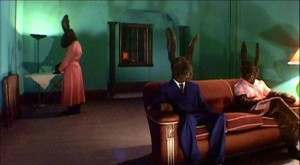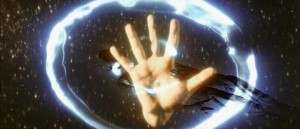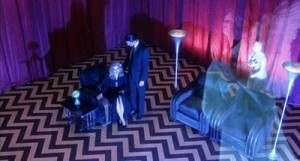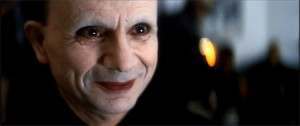IN many of his films, director David Lynch demonstrates an unnerving capacity to tap into surreal and disturbing dream imagery. This imagery often demands analysis or interpretation, not to mention the full engagement of the audience.
In short, you either follow Lynch willingly down the rabbit hole of visual symbolism, or you do so kicking and screaming.
If you choose the latter trajectory, then you likely reject his bizarre phantasms as either “nonsense” or merely as “meaningless.” If you choose the former route, you may find his bizarre films something akin to a mind-altering experience…and also deeply meaningful.
With such thoughts in mind, my selections for the four most underrated Lynch film experiences are those in which the narrative elements involve dreams, or the movies function as waking dreams themselves.
My choices (in chronological order) are as follows:
Dune (1984)
Let’s get this out of the way first: a movie can’t be a book, and a book can’t be a movie. This 1984 science fiction effort is David Lynch’s Dune, not Frank Herbert’s Dune and that fact is a good starting place for a better understanding of the film.
Critics including Roger Ebert and Gene Siskel counted Dune as one of the worst films of 1984, but the film is best understood in terms of Lynch’s devotion to dream imagery. All the meaningful action of the film, in fact, revolves around dreaming as a way of acquiring knowledge. In other words, the narrative moves forward only because the presence (and content) of dream imagery.
Before his family moves to Caladan and before the “sleeper” awakens on the desert planet Arrakis, Duke Leto’s son, Paul Atreides (Kyle Maclachlan) experiences prophetic dreams; dreams that foretell of his destiny, and his crucial role shaping the universe. He dreams of Dune’s second moon, Maud’D’ib and his future Fremen lover, Chani (Sean Young), among other things.
As viewers, we understand that Paul’s dream — this prophecy — represents truth, or perhaps reality as it should be.
Later, when Paul’s destiny is in doubt because of the conflict with the Harkonnens, he explicitly ties belief in his dreams to faith in the force that presented him the dream. “God created Arrakis to train the faithful. One cannot go against the word of God,” he says. It is a Divine Force then that gave Paul the dreams, therefore, and inspired his actions.
At one point, when Paul is discouraged, this feeling arises explicitly because he feels cut off from his dreams. He experiences a moment of self-doubt. “All the images from my future are gone,” he reveals to Chani.
To highlight this point, Lynch cuts to a dream montage in which Dune’s second moon, Maud’Di’b cracks like an egg. This is what Paul dreads: the shattering of his dreams and his failure to achieve his destiny.
“I’m dead to everyone unless I become what I may be,” Paul declares. Thus he decides he must drink the Water of Life, a dangerous act which will rekindle his dreams and his second sight. For Paul, the “sleeper must awaken,” and to undergo this process of self-actualization he must tap once more into the universe of dreams.
Because of Paul’s dream, a revolution is launched, and the Fremen take a place of importance in the scheme of things. The film’s message is that one leader with a “vision” can change destiny, and the dream imagery transmits this point beautifully.
Twin Peaks: Fire Walk with Me (1992)
This widely reviled movie sequel to the popular cult-TV series of 1990 -1991 concerns the last days of Laura Palmer (Sheryl Lee) a small-town golden girl with many, many secrets. Once more a sense of the dream world permeates a Lynch movie.
A drug user and a sex addict, Palmer is also a victim of sexual abuse. Palmer foresees her own death in the film, and interacts with a dream world — called The Black Lodge — of strange personalities. Among these personalities are the evil spirit Bob, the backwards-Talking Man from Another Place (Michael Anderson) and the One-Armed Man.
In this case, Lynch posits an alternate or spiritual world that interacts with the world of dreams. Laura herself feels she is protected by another non-human character: a guardian angel. But during the course of the film — and leading up to her murder — she fears it has abandoned her.
What remains so profound about Laura Palmer’s tragedy today is that, in the very end, David Lynch grants the character a small measure of contentment. The guardian angel she believed she lost during her last, brutal hours on Earth, returns anew (in the afterlife) to heal her pain; even as good Dale Cooper (Maclachlan again) lands a comforting, supportive arm on her shoulder. Our last view of the cheerleader is of Laura smiling.
In life, Laura was relentlessly victimized…her goodness burned away by life’s ugliness. In death’s sitting room, of all places, peace is finally at hand. Although this viewpoint may seem decidedly bleak, it also represents Lynch’s balancing of the spiritual world. The dream world of the Black Lodge may be a place of garmonbozia — death and suffering — but it isn’t populated merely by the likes of murderous Bob and the Man From Another Place. The winged celestial being is there too, the seraph, and that means that forgiveness, redemption, and transcendence are at hand.
Lost Highway (1997)
A restless spirit of madness haunts musician Fred Madison (Bill Pullman) in Lost Highway. That spirit, while actually a part of Fred’s psyche, is manifested externally in the film as another “being” that he physically encounters. Specifically, this specter takes the form of the pasty-faced, grinning maniac portrayed by Robert Blake.
In the film’s most deeply unsettling, most dream-like sequence, this specter of violence and guilt confronts Fred at a party and informs the saxophonist that he, the Mystery Man, is actually at his house right now, killing his wife
Of course, a person can’t be in two places at the same time but the Mystery Man urges Fred to call his own house to confirm this fact. Fred calls, and at his house the Mystery Man answers. “I told you I was here,” he says.
The idea underlining this horrific, surreal sequence is that Fred has effectively disassociated from himself, from his personal identity, in order to carry out an evil, brutal deed: the murder of Renee.
Fred subconscious has created a Boogeyman, a monster, to complete the task for him, since — as a rational, evolved human being — murder is not an acceptable act. Instead, Madison has reached deep down into his reptilian brain and created this thing, this monster. While his evolved, human psyche dreams, his subconscious identity commits murder.
Psychogenic fugues or dis-associative orders are often precipitated by intense stress, and the early scenes of Lost Highway explore this aspect of Madison’s life. Fred suffers from an inferiority complex while in bed with Renee, and cannot complete intercourse. When he proves impotent, we see a flash of Blake’s character, the Mystery Man, coming into being.
Similarly, Fred is consumed with jealousy and rage (in large part represented by red rooms or decorations in the film.) After a public musical performance, Fred rings Renee up on a red telephone and he’s likewise bathed in hellish neon-sort of red light. She’s not home, and Madison’s conviction that she is cheating on him grows exponentially. His very world seems to visualize this “red” streak of jealousy. Unable to get satisfaction from her husband, Renee has sought fulfillment outside the relationship…or so he imagines.
After creating the “mystery man” as an alternate identity from which to commit the murder of cheating Renee, Fred then disassociates again after the crime, creating an additional personality, Peter Dayton, where he can hide from his intense feelings of guilt and responsibility. Those unlucky souls who experience psychogenic fugues in real life often create totally new personalities, in new environs, with no memory of their real personalities or histories, and that seems like Fred’s problem here.
Some critics have interpreted Lost Highway as David Lynch’s examination of the motivating forces (jealousy and madness) behind the O.J. Simpson murders of the mid-1990s. Lost Highway tells a similar story of jealousy and rage, but imagines a culprit who creates an alter-ego out of dreams to do his dirty work. This is movie-making as a psychological disorder, and beautifully crafted.
Inland Empire (2006)
The most opaque and complex of David Lynch’s dream pictures is 2006’s Inland Empire. The film depicts a psychic “gateway” to other worlds, other realities, like the Black Lodge of Twin Peaks or the world-opening/changing “box” of the widely-acclaimed Mulholland Drive. Here, there’s a gateway tagged with the legend AXXoNN that transports the protagonist, Nikki Grace, from one reality to another; from one state of being to another. On the surface it’s just a door with those letters scrawled roughly in chalk on it.
However,”AXXoNN” is a close approximation of the word “axon.” An axon is a nerve cell, basically, linking one portion of the brain to another, one that carries thoughts. The AXXoNN gate in Inland Empire fulfills much the same function. In the film, it links realities, identities, dreams and even disparate time periods together. Nikki navigates this gate and taps not into something personal (the “day residue” of dreams described Freud) but something much more Jungian in concept: an unconscious idea hidden in the conscious mind of the race itself; something about the “genetic” memory of women; of womanhood/sisterhood itself.
I discussed in my review of Lynch’s Dune how Paul Atreides’ dreams seemed to originate with the Divine, one important school of dream interpretation. In Inland Empire, the dream sense of David Lynch suggests supernatural communication instead; the magical linking of at least two women (Sue and Nikki), and perhaps more, across time and space The magical AXXoNN gate is a symbol for the human mind. The “longest running show” in human history is the human collective memory, in this case the female of the species’ collective memory of sexual violence and abuse through the ages, across the globe.
The perpetrators of such violence are symbolized in Inland Empire as one male uber-being or presence, the “Shadow,” a recurring monster figure. The Shadow is the Blurry Man in the film’s opening scene who demands sex, and also an unseen killer on the prowl in Poland. Finally, he is monstrous man “guarding” room 47 and keeping a woman locked up there. When Nikki shoots this Shadow, he changes shape. First he is a horrible female thin, but then he shows his true visage and it is both monstrous and terrifying.
The Gypsy (Zabriskie) has prepared us for the presence of this thing in her first scene: “A little boy went out to play. When he opened his door, he saw the world. As he passed through the doorway, he caused a reflection. Evil was born. Evil was born, and followed the boy.” The Evil that has followed thus “little boy” is the mistreatment of women; the “dark side” (or reflection) of manhood.
But by taking on the role of “Sue” in the movie, by becoming the receptacle for the remake’s “curse,” Nikki has crossed the gate and become aware of the collective memory of abuse in the “sisterhood” of women, and it is up to her to free the woman in the hotel (again, perhaps Sue herself…) who has been trapped there, unable to return to her husband and son because of the “box” (of sexuality?) where the Shadow has locked her up.
Once more, there is sort of dream logic to a Lynch film. For instance, in dreams, time is both fluid and meaningless. Inland Empire’s dialogue reinforces this nation. “In the future, you’ll be dreaming,” or “I figured one day I’d just wake up and find out what the hell yesterday was all about,” or “This is a story that happened yesterday, but I know its tomorrow.”
This is the dream sense of Inland Empire, and it is a quality we see again and again in the underrated film productions of David Lynch. We jump from one reality to another without conventional physical travel. The connections forged in the 2006 film are the connections of the mind, the subway path of the axons, the AXXoNN gate. A thought triggers another thought and we witness this progression of ideas played out. Only here, an idea in a scene (like the abuse of women) triggers another scene that’s a variation on that theme, and on and on. The connections are the light-speed connections of cognition itself, of thought.
David Lynch’s films are remarkable, but often dismissed as meaningless, because the artist treads so deeply into dreams as prophecy (like in Dune), dreams as a spiritual world walking hand-in-hand with ours (Twin Peaks: Fire Walk with Me), as dis-associative alter egos (Lost Highway) and even as gateways to man’s collective memory and history (Inland Empire).
Would you like to support Flashbak?
Please consider making a donation to our site. We don't want to rely on ads to bring you the best of visual culture. You can also support us by signing up to our Mailing List. And you can also follow us on Facebook, Instagram and Twitter. For great art and culture delivered to your door, visit our shop.






